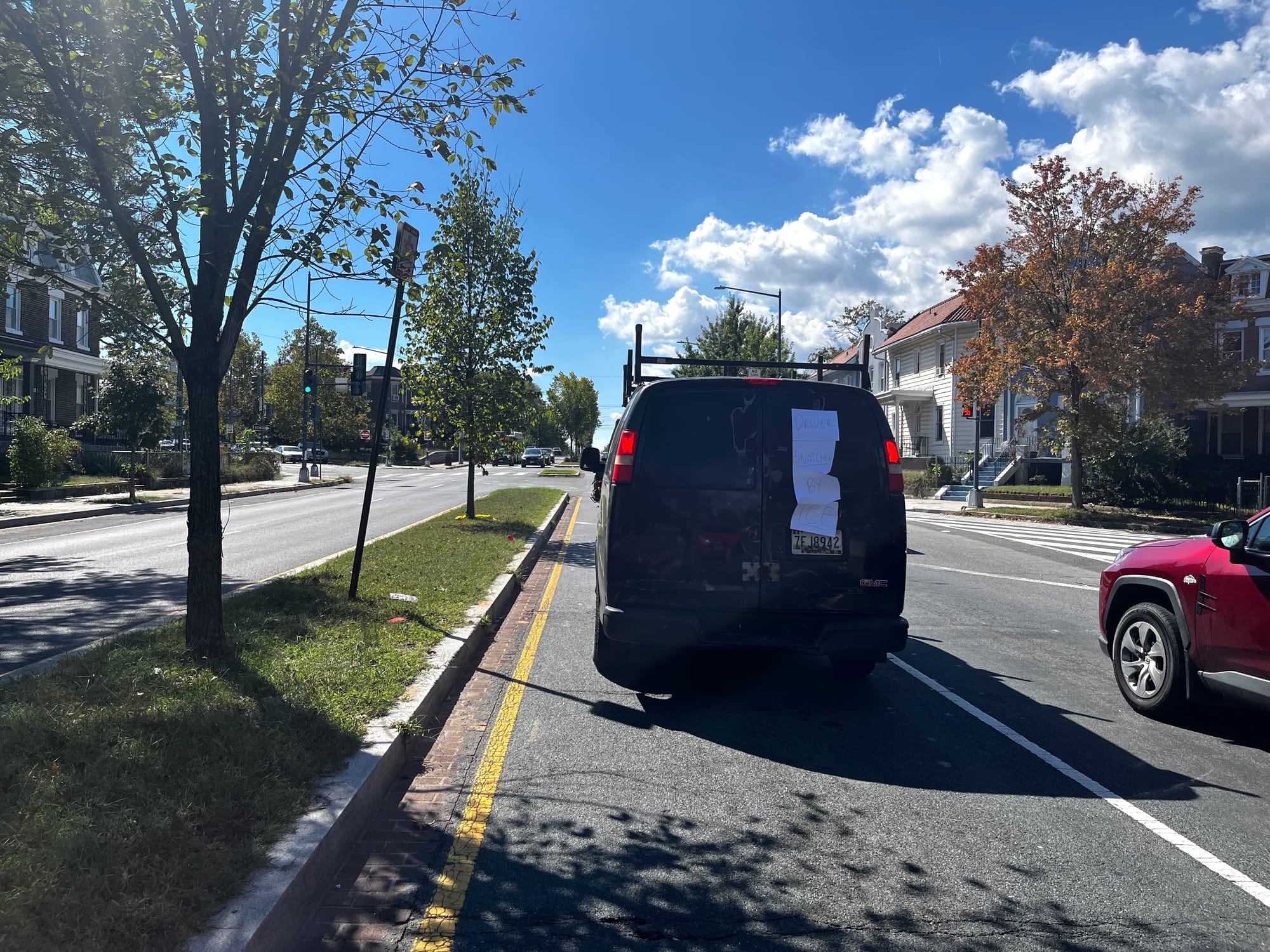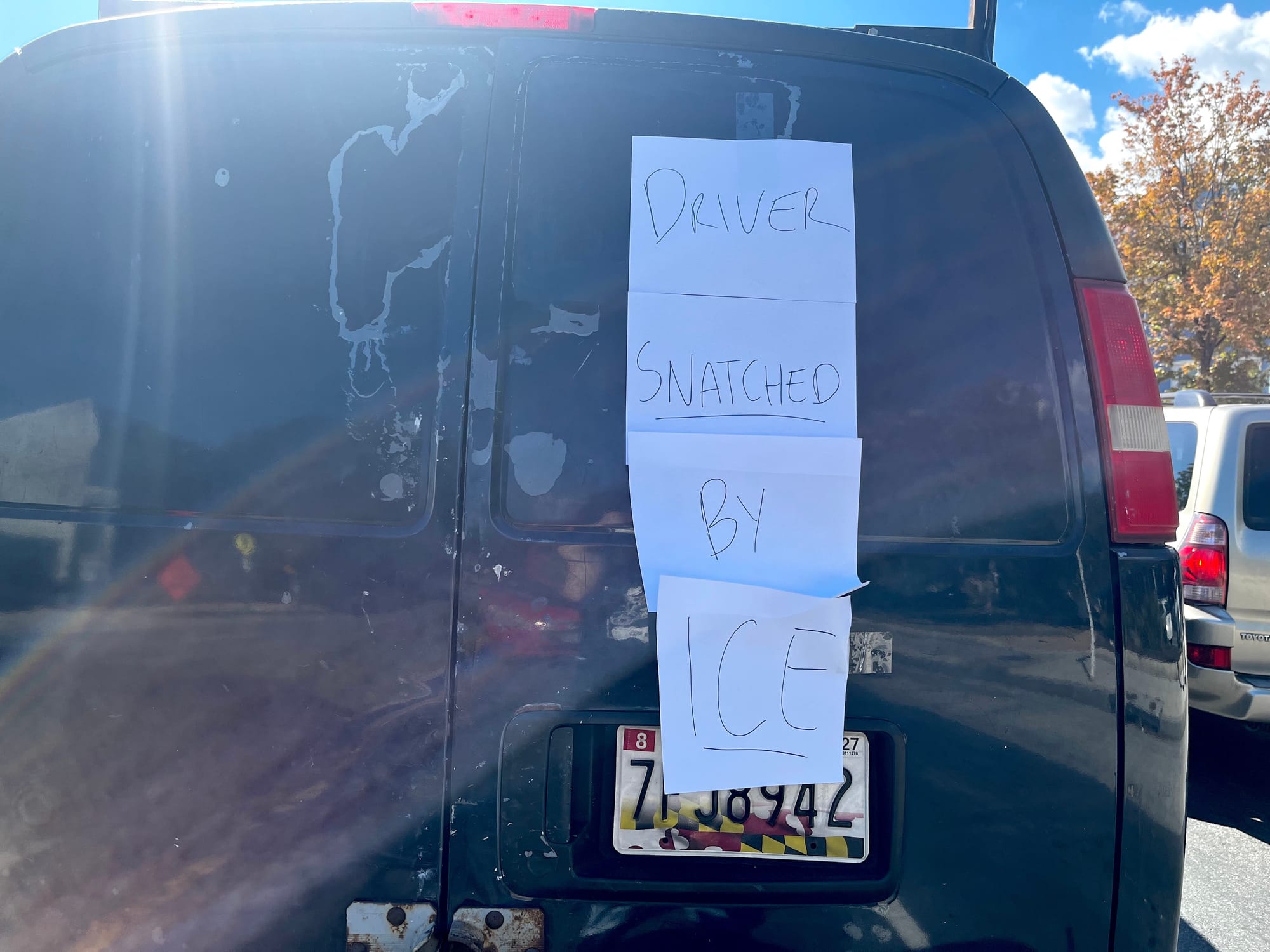The unexpected costs of running The 51st
So you're telling me ... it's more expensive to be a newsroom in D.C.?
Local cooperation with immigration enforcement has become a flash point since the federal surge in D.C.

Dozens of speakers had already decried what they said was obvious and troubling collaboration between the Metropolitan Police Department and Immigration and Customs Enforcement. But as the four-hour D.C. Council hearing came to a close on Wednesday afternoon, activists held up a phone and said they wanted lawmakers to see it in action.
“Go see the fucking collaboration,” said one activist who only went by Brendan, pointing at video clips on his phone that showed a mix of federal and local police officers making arrests at that moment on a Georgia Avenue NW Metrobus some three miles north of the Wilson Building.
The brief confrontation capped off the first formal opportunity the council had given residents and activists to sound off on increased cooperation between MPD and ICE since President Donald Trump declared a crime emergency in mid-August, flooding the city with federal law enforcement officers — many of whom have focused on immigration enforcement. More than 50 people signed up to speak, the maximum allowed.
That enforcement — and the role MPD officers have played in assisting it — has provoked broad criticism, raised concerns that the police department is damaging trust built up over years with local communities, and sparked calls for Mayor Muriel Bowser and lawmakers to be more forthcoming about what exactly local police officers are doing.
“To say that D.C. residents are traumatized by the surge of federal agents and stepped-up immigration enforcement is not hyperbole,” said Ward 1 Councilmember Brianne Nadeau, who called the hearing under the guise of exploring whether human rights violations have taken place.
“I personally have heard multiple stories of parents snatched by masked and unidentified agents. I’ve witnessed incidents, as well. We’ve heard of kids left on their own after parents have been removed. We’ve heard of U.S. citizens being detained without warrants and with no apparent reason,” she added. “And in many of these cases, D.C. police have participated.”
At the beginning of the surge, Police Chief Pamela Smith issued an order to officers saying that they could help immigration agents in limited circumstances, but the details of what officers are instructed or allowed to do remain unclear to the general public. Bowser has said she doesn't want ICE or other federal agencies focused on immigration enforcement operating in D.C., but it still isn't clear how much she has pushed the point with the Trump administration.
Speaker after speaker relayed stories of immigration detentions with some criticizing ICE for engaging in “violent and racially motivated” stops. Advocates and immigrant residents themselves spoke of heightened fear when they go outside, with some now opting to carry passports or other paperwork at all times or refusing to go to certain areas where ICE agents have been known to operate.
“For generations, immigrants have been invisible constituents of D.C.,” said Leny Gomez of the Colectivo de Familias Migrantes, a local organization that advocates on behalf of immigrants. “Mayor Muriel Bowser previously rallied in our neighborhoods… and today she betrays us, handing our communities to masked agents. Immigrants are Washingtonians.”
More than 1,400 people have been arrested on immigration violations in D.C. since the federal surge began, according to data from last month. (We have asked the White House for more recent data, but have not heard back.)
Madhvi Bahl, an organizer with the Migrant Solidarity Mutual Aid Network, said that the group has received 4,852 calls to its hotline since the middle of August; in roughly the same amount of time before the surge, it only logged 743 calls. “You don’t need data to know this is wrong, just eyes and a soul,” she said.


A van was left abandoned on New Hampshire Ave. NW in early October, with a handwritten sign on it that read, "Driver snatched by ICE." (Maddie Poore)
Many shared stories of ICE arrests near schools as students arrived or departed. One resident said federal agents frequently loitered near two entrances of a public school in Petworth, prompting some families to avoid taking their children to school altogether. Daniela Anello, the CEO of the D.C. Bilingual Public Charter School in Ward 5, recalled one arrest that happened across the street from the school’s entrance earlier this month.
“One man was violently tackled to the ground by three armed agents. Imagine: hundreds of children arriving, holding their parents’ hands, watching a person who looked like their father, cousin or older brother, tackled, lifted off the ground and dragged away by three masked men right in front of them,” she said. “No child should witness violence on their school doorstep.”
But while much of the testimony addressed what immigrants and members of the city’s Latino community have experienced, it wasn’t limited to that. Speakers pointed to an incident earlier this month where a federal agent patrolling with D.C. police shot at an unarmed Black driver during a traffic stop. One of the local officers later told a judge that he was instructed to exclude any mention of the shooting from official police reports. Shootings by D.C. police officers, on the other hand, are regularly investigated. (On Thursday police officials said the officer was not instructed by a superior, but advised by a colleague.)
“I’ve been all over the city. I’ve seen how they’re operating. Jumping out in neighborhoods harassing people. If that person got shot, how do you know they won’t shoot someone else?” said David Black, a resident who shared that he had recently been pulled over by U.S. Park Police on Benning Road for what he said was an unjustified traffic stop. “Who’s there to stop them?”
Ward 1 resident Tyler Sylvester testified that he had been violently arrested by federal police officers in Judiciary Square as he recorded and heckled them at a distance. Sylvester now faces a charge of disorderly conduct for what he says was a simple — if crude — act of exercising his First Amendment rights.
“I think all of these organizations are becoming intertwined and the lines are becoming quite blurred about whose job is what,” he said of federal and local police working together. “This collaboration is not just increasing the violence they are enacting on the community, it’s decreasing the trust on the other end.”
Miguel Trindade Deramo, an Advisory Neighborhood Commissioner in Ward 1, alluded to that diminishing trust in his own testimony. “When we call 911, who will respond? Is it safe to call 911?” he asked.
What meaningful action Bowser and the council can take, though, was a prevailing theme throughout the hearing. Various speakers recognized that D.C. cannot ban ICE from operating within city limits, and also that D.C.’s limited autonomy can make it risky for city officials to push back too forcefully against Trump. (Nadeau conceded after the hearing that a “hostile Congress and hostile president” could limit what the council does.)
But they also said that it seemed like neither Bowser nor the council had even been trying to resist.
“You should all be ashamed for the lack of a sense of urgency,” said Frankie Seabron, an organizer with Harriet’s Wildest Dreams and CourtWatch, which has monitored the significant uptick in arrests. “Either get with the people, or fall with the empire. Fight with us, y’all, or get to the side.”
At the bare minimum, residents and activists said MPD should stop working with ICE. They also said the council should do more aggressive oversight of MPD’s current cooperation with immigration authorities — and whether it complies with the existing Sanctuary Values Act, the six-year-old law restricting how much city agencies can assist with immigration enforcement. (Bowser tried to repeal that law earlier this year, and The 51st has learned that she again pitched the idea last month.)
That oversight would have to come from the council’s judiciary committee, which oversees MPD and is chaired by Ward 2 Councilmember Brooke Pinto. Last week Pinto told The 51st that she remains in constant contact with MPD leaders, and in a statement on Wednesday said she believes that what ICE has been doing in D.C. is “deeply troubling.” But she hasn’t committed to holding a stand-alone public hearing, instead saying residents can use other hearings she has scheduled to share their experiences.
That’s not enough for some groups, though. On Wednesday, the Colectivo along with the Free DC Project, which has organized the resistance to federal interference in the city, launched a campaign demanding that Pinto call a hearing.
At-Large Councilmember Robert White, who is running for D.C. delegate to Congress, joined them, arguing that it would give MPD leaders the chance to clear the air. “If there’s no coordination, come to the council and testify to that. Say that there is no coordination but say it honestly, because we all see what’s happening in this city right now. It’s making people afraid,” he said. (Pinto is also running for D.C. delegate.)
While Bowser said last month that ICE’s presence in D.C. had been “terrorizing” some communities and that she opposes the agency’s continued activities in the city, she has since shied away from answering questions about what exactly MPD is doing with immigration agents. And on Wednesday she seemed dismissive of many of the concerns and criticisms being shared at the hearing.
“I just talked to a lot of residents here. Nobody told me they were upset with me. In fact what they told me was, ‘Thank you mayor for your leadership during unprecedented times,’” she said outside an event in upper Northwest. “I know that we have entered a political season as elections are approaching. You have councilmembers who are doing very unusual things like having hearings over things they have no jurisdiction over. The council can do what it wants to do, and I’m always listening to residents.”
But NBC 4 reporter Mark Segraves pointed out that her sample may not be representative of broader opinions in the city. “I don’t think Chevy Chase is a hotbed of ICE activity,” he pointed out. And Nadeau later dismissed Bowser’s accusation, noting that she herself is not running for re-election to the council.
Some of the speakers at the hearing did propose concrete actions the city could take, specifically around how schools have been impacted. They said D.C. officials should meet with school leaders, issue formal and clear guidance on what rights students and families have, and even help offset some of the financial costs that schools have taken on to support immigrant families. (One speaker said a school was spending $20,000 a month to help transport vulnerable kids.)
“We are all mobilizing … but every school doing this alone is not a cohesive strategy for supporting our immigrant families,” said Anello.
She added that D.C. officials could broker a meeting between school leaders and ICE to negotiate an end to detentions around school buildings. Earlier this year, Trump rescinded a standing policy that restricted ICE activities around “sensitive locations” like schools, churches, and hospitals.
Separately, pressure may be building on MPD to respond to the allegations that it ordered an officer to not report on the federal agent who shot the unarmed Black motorist. On Tuesday, At-Large Councilmember Kenyan McDuffie sent a letter to Police Chief Pamela Smith demanding answers.
Ultimately, many speakers at the council hearing said they just wanted to feel like their elected officials were listening to them. As Ward 4 resident Alexandra Simbana put it, “This moment needs leaders.”
With your help, we pursue stories that hold leaders to account, demystify opaque city and civic processes, and celebrate the idiosyncrasies that make us proud to call D.C. home. Put simply, our mission is to make it easier — and more fun — to live in the District. Our members help keep local news free and independent for all: